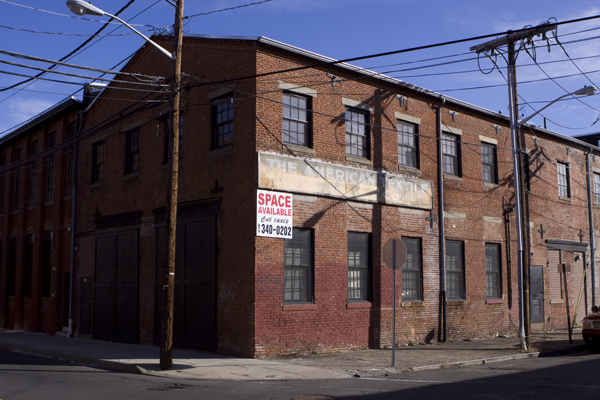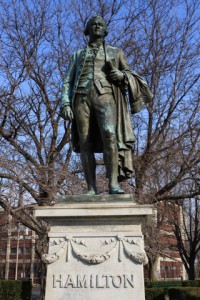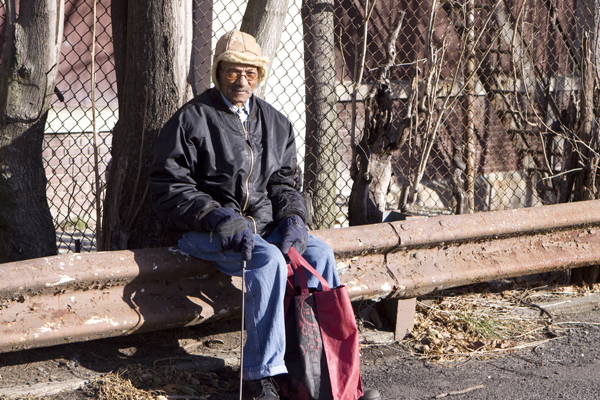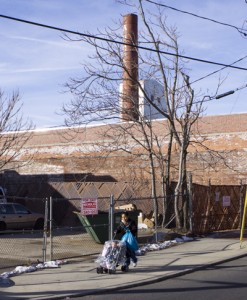DEP Holds Private Briefing with Mayor Today on Paterson Air Study
[Update #1: the Final Report and Citizens’ guide were just posted to DEP website – I update important FINDINGS/DELETIONS]
[Update#2 – Mayor’s response below – IMPORTANT CORRECTIONS NOTED
 Having been caught with their pants down, in response to yesterday’s leak of a “communications” strategy and “messaging” campaign (see this), the Department of Environmental Protection (DEP) canceled Wednesday’s scheduled public meeting in Paterson, NJ. [Update: per the Mayor’s Office, the meeting tomorrow is on, but DEP press release just issued says nothing about a meeting]. The meeting was to brief the Paterson community on the results of a 5 year long, $740,000 study of toxic air pollution health risks.
Having been caught with their pants down, in response to yesterday’s leak of a “communications” strategy and “messaging” campaign (see this), the Department of Environmental Protection (DEP) canceled Wednesday’s scheduled public meeting in Paterson, NJ. [Update: per the Mayor’s Office, the meeting tomorrow is on, but DEP press release just issued says nothing about a meeting]. The meeting was to brief the Paterson community on the results of a 5 year long, $740,000 study of toxic air pollution health risks.
 Instead of publicly presenting the scientific research and openly responding to community concerns, the DEP and hand picked community leaders met privately today behind closed doors in the Mayors office to discuss the controversial matter. [Update: per the Mayor’s office, the meeting was for elected and appointed officials, but my sources say community reps were there as well]. Today’s meeting with the Mayor follows a Monday meeting between community leaders and Congressman Bill Pascrell.
Instead of publicly presenting the scientific research and openly responding to community concerns, the DEP and hand picked community leaders met privately today behind closed doors in the Mayors office to discuss the controversial matter. [Update: per the Mayor’s office, the meeting was for elected and appointed officials, but my sources say community reps were there as well]. Today’s meeting with the Mayor follows a Monday meeting between community leaders and Congressman Bill Pascrell.
I’ve been advised that there is political pressure being brought to keep the study’s findings quiet, because it might give Paterson a black eye and discourage redevelopment investment. Those like me who advocate full public disclosure and scientific integrity are being labeled and attacked as seeking to bash Paterson.
I can see why DEP has canceled the public meeting, because they would have faced some harsh questions about why their “communications” plan and “Citizens Guide” were so sharply at odds with the science and thus highly misleading. Here are just a few of the more egregious examples:
1. Why was Paterson selected for the research study:
The DEP “Citizens Guide” claims the following: click to see the draft DEP Citizens Guide (with staff edits)
Why was Paterson selected for this study?
Paterson City was chosen because it represents an urban community with mixed land use; commercial, industrial, mobile and residential, not because of concerns that air quality in Paterson is worse than in other New Jersey urban communities.
But DEP left some important facts out that directly contradict that claim. The EPA grant agreement, DEP powerpoint presentations, and a copy of the draft study I obtained state that Paterson was selected due to pollution “hot spots”, serious high air pollution related health problems, pollution close to schools, children’s health, and “environmental justice” issues. Paterson was a followup to the Camden air toxics/environmental justice study.
Significantly, the Paterson study was the first DEP attempt to calculate “cumulative risk” by estimating “combined cancer risks” of multiple pollutants – this is a cutting edge EJ public health issue, see: EJAC 2009 Report: Strategies for Addressing Cumulative Impacts in Environmental Justice Communities-March 2009 – yet all this is ignored. [Update: the risk assessment and “combined cancer risks” in the draft report have been deleted from the Final Report posted on DEP website]
Here is what the draft Study says:
A. Why Paterson?
Paterson was chosen for this project because it is a mixed-use urban community with high population density and many of the characteristics of an environmental justice community. [Paterson] was selected because it qualifies as an air toxics “hot spot” due to the industrial (e.g. textiles; dyes; chemicals; metal fabrication, refinishing and recovery; plastics; printing; electronics; paper and food products, etc) commercial (e.g. dry cleaning; photo labs; commercial heaters/boilers; print shops, etc) and mobile sources (US I-80, Rt. 19) dominated sectors… Schools have been chosen as monitoring site locations allow UCAMPP the unique opportunity to monitor air toxics where children, a susceptible subpopulation, spend a portion of their time.
Paterson has all the characteristics of an environmental justice community with a disproportionately large percentage of families living at or below the poverty level. Nineteen percent of the families in Paterson live at or under the poverty level compared to 6.3% for the state. There are 149,000 residents, of which 1/3 are white, 1/3 black and the balance are some other race. Fifty percent of the population considers themselves to bee Hispanic or Latino. The population density is over 17,210 people per square mile.
Paterson has more than three times the state average for hospitalization rates due to asthma (Wallace, 2003). A study in Paterson (Freeman et al, 2002) found that 21% of third graders had been diagnosed with asthma or a related health problem. Paterson… has the fifth highest hospitalization rate for asthma in NJ (NJDHSS, 2003). Twenty eight air toxics (Leikauf, 2002) have been associated with exacerbations of asthma and the 1996 [EPA] National Air Toxics Assessment identified fourteen air toxics which are causing elevated cancer and non-cancer risks (NJDEP, 2003) in Passaic County
[Update: All three of these paragraphs were deleted in the Final Report. In concert with deletion of the “combined cancer risk” findings on cumulative risks, this is a serious misleading effort by DEP to downplay health risks].
There is more than a slight disagreement between DEP science and DEP spin.
2. The nature of the health risks
DEP systematically downplays public health risks of the pollution levels they found by omitting key scientific findings from the study, the high air pollution related health problems cited in #1 above, while inserting claims not found in the study. For example:
- “There is no immediate public health concern†– a conclusion that ignores evidence of significant long-term and cumulative effects;
- “The air quality in Paterson is consistent with that of the entire state†– a vague statement that ignores that the study was designed with a background monitoring station in Chester, NJ and many other specific findings such as chlorine levels in Paterson more than 100 times higher than EPA national model estimates; and
- “The cancer risk [for p-dichlorobenzene, one of 132 toxics measured] calculated at the one site in Paterson where the elevated concentrations occurred would be 205 in a million†while neglecting to mention that this is more than 200 times the one in a million cancer risk guideline used by DEP and that even higher cancer risks were found at other monitoring sites
- DEP completely fails to mention that the study found the “combined cancer risk†from exposure to toxic chemicals at the high end of what the U.S. EPA considers acceptable risk, and over 700 times higher than New Jersey’s cancer risk standard of one in a million
3. The urgency of DEP follow-up actions to reduce risks
DEP tried to create the appearance that they are aggressively taking action to reduce cancer causing air pollution emissions from industrial sources in Paterson. They claim:
The NJDEP enforcement program is investigating the possible source(s) of the elevated p-dichlorobenzene.
However, internal DEP emails I obtained document that DEP was aware of the problem since August of 2007, and had a specific local industry, Galaxi Chemical and a local garbage transfer station, targeted, yet for over two years appears not to have resolved the scientific issue and taken enforcement action. According to an August 23, 2007 DEP scientists email:
Linda – Here’s what I found out about 1,4 Dichlorobenze. It looks like the possible suspect could be Galaxie Chemical, which is less than 1/2 mile and just north of the C monitor. Their inventoried emission rate most likely will not account for your high numbers therefore it may be a situation where the company is in violation of their permit. We did not visit Galaxie, we did do a rive by early on with Mike Burgdoff (enforcement) and the place looked old and dirty.
4. The purpose and objective of the community outreach:
First of all, despite the study being over 5 years old, DEP only created their “communications plan” AFTER the Bergen Record wrote this story that put them in a very negative light: “Study Finds Paterson Has Significantly Higher Levels of Air Pollutants” (titled “City’s Air May Raise Cance Risk” in the Paterson edition)
Furthermore, DEP fails to state why they are conducting community outreach. According to their “messaging” plan, it appears that the DEP objective is to get their story straight and manipulate – instead of informing and responding to the community:
NJDEP will share report, citizen’s guide and FAQ with DHSS to provide consistent information/message.
I filed an OPRA public records request to obtain the study and all documents back on December 9, 2009. DEP claimed that some documents were privileged. Over 2 months later, I still do not have OPRA compliance, as DEP is withholding many documents, including: the final study, the transmittal letter to EPA, several meeting notes, emails, internal technical review comments, internal source track down comments, DEPÂ permit and enforcement documents, DEP management briefings, emissions source inventory, and current enforcement status (i.e. from data I obtained from DEP files, it looks like about $3 million in fines may not have been collected for at least 5 years).
I just spoke with Mayor Torres’ office and was promised a call back by the Mayor. I forwarded them the following questions. We will keep you posted on the responses we get.
1) Who was today’s meeting with (from DEP and community)? What was the agenda? And what was the gist and outcome of the meeting?
2) Do you have a statement on the DEP UCAMPP study? Are you concerned about the cancer and asthma health risks documented in that study? Are you concerned about the delay by DEP in completing the study and briefing the Paterson community?
3) Why was Wednesday’s scheduled public meeting to present the study canceled? Will a public meeting be rescheduled?
4) What are your going forward plans to address the issues and reduce air pollution emissions in Paterson?

[Update #2 – Below is Mayor Torres’s response to the above questions –
The following is in response to your questions:
1)Â Â Â Â Â Â Â Â Â Â Â Â Â Â Â Â Â Â Elected and Appointed Officials Debriefing.
2)Â Â Â Â Â Â Â Â Â Â Â Â Â Â Â Â Â Â Data has been submitted to my Environmental Specialist and Health Officer for comments and recommendations.
3)                  At this time, the community briefing has not been cancelled. However, should the decision be made to postpone due to inclement weather, the community briefing will take place on February 24, 2010, 5:30 p.m. in the Paterson City Hall Council Chambers, 155 Market Street – 3rd Floor, Paterson, NJ.
4)Â Â Â Â Â Â Â Â Â Â Â Â Â Â Â Â Â Â EPA awarded NJDEP a $157,000 grant to conduct 12 months of additional monitoring in the City of Paterson and an educational and enforcement campaign will be implemented.
Mayor  Jose “joey†Torres
Office of the Mayor
973-321-1600 (Telephone)
973-321-1555 (Fax)
mayortorres@patcity.com
 Trenton – A groundbreaking but long-delayed study of toxic air pollution in Paterson, New Jersey is finally being released this week with an elaborate state public relations roll-out designed to convince people that it contains nothing new, according to documents released today by Public Employees for Environmental Responsibility (PEER). Yet the draft of the study indicates that there are significantly increased health risks to residents from breathing ambient levels of numerous hazardous air pollutants.
Trenton – A groundbreaking but long-delayed study of toxic air pollution in Paterson, New Jersey is finally being released this week with an elaborate state public relations roll-out designed to convince people that it contains nothing new, according to documents released today by Public Employees for Environmental Responsibility (PEER). Yet the draft of the study indicates that there are significantly increased health risks to residents from breathing ambient levels of numerous hazardous air pollutants.
